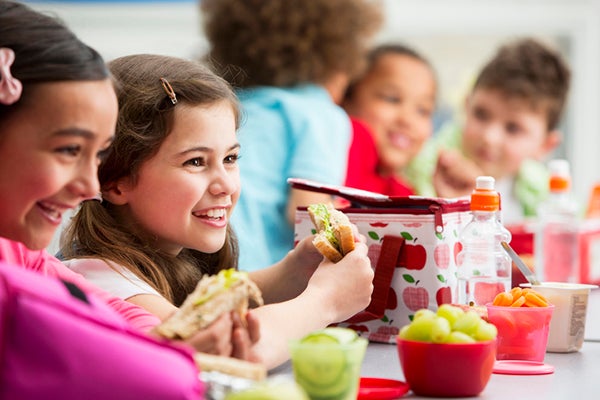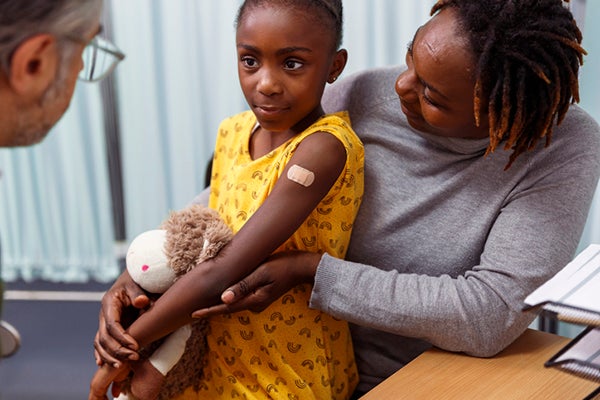Healthy Habits for a Happy School Year
August 14, 2024
By: WakeMed Children's Hospital
Categories: Children's, Primary Care, diet & nutrition
Tags: back-to-school
Each new school year comes with a mix of excitement, challenges and checklists for families. Whether your child is getting started with kindergarten or cruising through the teens, parents can help kids start off right with some basics.
We asked experienced parents from the WakeMed Children’s medical team to weigh in on what matters the most when it comes to a child’s development, learning experiences and school readiness. They recommended focusing on annual well-child visits, healthy routines, nourishment, physical activity and mindful use of screens.
Start the Day Right

Breakfast is important and sets the stage for the day by giving kids the energy they need to do well in school as well as play and have fun.
“When breakfast is skipped, I often see kids who feel tired, and they are starving when they come home from school, which can lead to overeating into the night,” says Shirley Huang, MD, associate medical director, WakeMed Children’s – Pediatric Weight Management.
Jumpstart the Day

Mornings can be busy, especially when kids (and parents) want to sleep as long as possible.
Dr. Huang suggests:
- Go to bed 15 minutes earlier and get up 15 minutes earlier. It may not seem like that much of a difference, but each minute counts in the morning! This may actually be just enough time for kids to eat something before starting their day.
- Be ok with not eating a big breakfast. Many kids are just not hungry in the morning, but it is still important to fill their gas tank at least a little bit in the morning. A piece of fruit, yogurt or toast is totally ok.
- Keep grab and go foods at eye level in the refrigerator or pantry. Some good options are low-fat string cheese, an apple or a protein bar. Place containers stocked with these items in logical spots so kids know where to get something quick in the morning.
Easy Ideas for a Nourishing Breakfast

- Hard boiled egg + piece of fruit
- Slice of whole grain bread + jelly + yogurt
- Whole grain cereal + banana slices
- Protein waffles + peanut butter
- Greek yogurt + berries
- Smoothies with sweet fruit/berries + spinach or kale + water + chia or flax seeds
Children should eat three meals a day and up to two snacks a day if hungry.
“Fueling a child every two to four hours is okay,” explains Dr. Huang. “When possible, focus on giving kids mini meals that provide more nutrition and should help them feel more satisfied than just eating something like chips.”
Keeping kids’ food intake balanced during the school day can help fuel them through the afternoons.
“Children often will eat better when they’re able to choose from healthy options that they enjoy,” observes Samareh Hill, MD, medical director, WakeMed Children’s – Pediatric Weight Management. “Involve your children in choosing foods they want while teaching them that it is important to eat a combination of protein and fiber.”
Pack a Smart Lunch

- Pack lunches the night before, so it is less rushed and not forgotten.
- Include a reusable water bottle for a healthy beverage.
- Use a bento box and ice pack in a reusable insulated lunch bag to help keep food separate and cold.
- Use a thermos for packing heated foods that you want to keep warm.
- Variety helps increase the diversity of foods in a child's diet. Focus on two to three different protein, fruit or vegetable options and alternate through the week.
- Engage your child in choosing among several healthy ideas for their lunches or snacks and even have them help pack it to increase the chance they will eat it.
AFTERSCHOOL SNACK ATTACKS

“Kids do a lot during the school day and often use lots of energy to get through the day,” explains Dr. Huang. “It’s not a big concern if they are hungry after school at times, but parents should check in if they seem very hungry and overly low on energy after school.”
Are they skipping breakfast, lunch or both?
Sometimes kids don't eat because there's not enough time in the morning, they are not hungry yet or they don't like the school or packed lunches. Work with your children to get them eating meals consistently – even if it's small. And, encourage them to snack on more fulfilling and nourishing foods throughout the day, such as fresh fruits and vegetables.
Dr. Hill recommends providing afterschool snack options with two foods to help kids feel more satisfied until dinner. “I like to pair one food that is high in protein with one food that is high in fiber for snacks because these two types of food increase satiety and provide more nutrition.
FUN & TASTY SNACK COMBOS

- Apple Nachos – slices drizzled with peanut butter
- Strawberry Swirl – berries stirred into yogurt
- Hummus Cups – carrots sticking out of party cup with hummus
DON’T FORGET! VACCINES & SPORT PHYSICALS

At specific ages and stages, children need to get vaccinations, boosters and sports physicals. Check with your pediatrician well in advance of the start of school to make sure your rising kindergarten student has all the immunizations required.
Sports physicals are important for middle and high school students.
“The timing and need for completed forms might come as a surprise to parents if they have not previously had a child involved in school sports,” shares Renee Haynesworth, MD, pediatrician, WakeMed Children’s - Pediatric Primary Care (Fuquay-Varina). “Don’t wait until the last minute because it could delay your child’s ability to participate from the start.”
The American Academy of Pediatrics (AAP) recommends routine well-visits and sports physicals for all children in middle school, high school and college. The AAP suggests making a sports physical appointment six to eight weeks before the start of a sport season so there is time for any necessary follow-up evaluations or treatments. The AAP emphasizes that even if your child does not participate in an organized sport at school, they are likely participating in other activities such as skateboarding, cycling, hiking, musicals, gymnastics, climbing and other hobbies and new interests that are physically demanding.
This article is adapted from Families First magazine. Subscribe to our magazine today.